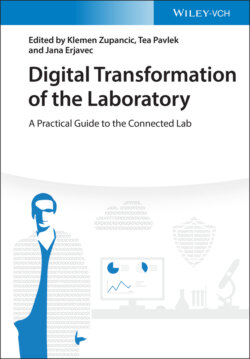Читать книгу Digital Transformation of the Laboratory - Группа авторов - Страница 24
1.2.5.3 Impact of AI and ML
ОглавлениеEven with all the hype around it, AI and its subtypes, e.g. ML, will undoubtedly reshape the R&D sector and have a huge impact on the LotF [85, 86]. Many see AI as the competitive edge which will accelerate products to market, or improve patient outcomes and care, and drive cost efficiencies. As a consequence, there now exists a major talent war as organizations seek to attract the best candidates.
With the rise of AI within life sciences and health care, it has become obvious that a key blocker to success is not the maturity of the AI tools and techniques but access to data in sufficient volume and quality for the AI and ML methods to operate meaningfully. The phrase “no data, no AI/ML” is a signature of the current challenge, with much of the accessible data having been created without due care and attention to reproducibility and the FAIR principles, which are only now driving business improvement in data collection and annotation. Depending on the AI/ML model being developed, having access to a broad cohort of data from across the particular domain will be critical to ensure the necessary diversity, edge cases, and breadth. It is this which will make the analyses successful and be broadly applicable.
The LotF will be both the source of new data to drive new insights from the AI predictive workflows and a beneficiary of the AI outputs which can augment the scientists' work. As mentioned earlier, voice activation, AR, and other assisted technologies all use elements of AI to support the user, whether as chatbots or more sophisticated experiment assistants for the scientist. For example, an automated AI assistant needs to be trained on data to enhance its capability. In time it learns from the human interactions, and this helps to improve its responses and output. Even without AI though, the drive for higher quality and more abundant data remains critical.
The role of AI in generating new ideas fits perhaps most cleanly in the in silico predictive, “design” workflows that have always existed in science. However, AI has the potential to produce new ideas not previously explored or considered by humans. For the lab scientist, the role of AI will be multivariate, from supporting the initial idea to be explored, through experimental design and execution, through to finally how the data is captured and the results analyzed. AI will augment the scientists' capability during their time in the lab as well as provide new insights to guide the best outcome from the experiment. For some, the likely benefit will be decreased experiment cycle times, allowing a better outcome in a fixed time period, for others it will be quicker decision‐making through linking the virtual with the physical. Complementary to this, using AI and robotics appropriately in the LotF will allow scientists to focus on the practical things that these technologies do not support well. This will make the fewer humans in the LotF more efficient and productive. Other “softer,” less technical factors will also become increasingly important going forward; these include the broader ethics of AI and the possible regulatory implications of using AI for R&D decisions. The clamor to solve these issues will become louder as the potential and positive impact of AI on life science and health care is demonstrated, validated through application of the AI models to real decision‐making.
